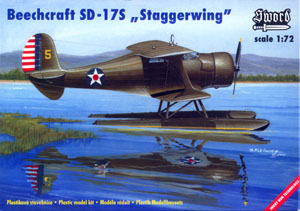Sword 1/72 SD-17S "Staggerwing" on FloatsBy Jim Schubert |  |
The Kit
Sword's new kit, #SW72017, is a follow-on to their earlier release of the Staggerwing on wheels, #SW72010, which was reviewed in the January 2001 issue of this magazine.† The History presented in that review is relevant to all Staggerwings, so I won't repeat it here.† Save for the requisite changes to the box art, instruction sheet and decals and the addition of a tree of parts peculiar to the float installation, this kit is identical to the earlier landplane issue.† All of the review comments of January apply to the airplane itself - and the airplane is quite good.
 I like seaplanes and was really looking forward to this release.† I am, alas, sadly disappointed by it.† The floats are just not right.† They're just barely in the ballpark, but only if you're the easy-going type.† They scale out to a length of 20' 4" and should be 20' 9" from the tip of the bow bumper to the transom.† They scale 37" deep at the step and should be 32".† The beam scales to 39" and should be only 36".† These dimensional discrepancies in the proportions of the floats completely spoil the profile elevation.† And, to top it off, their layout in the plan view is even more grossly incorrect.† A lot of research on the Grumman F4F-3S "Wildcatfish" earlier this year sensitized me to the appearance of Edo floats.† It was obvious at first glance, without taking any measurements, that these floats were wrong.† The float specified for the Staggerwing is Edo's model Wa 4665, which has a maximum displacement (for a ship-set) of 4,900 pounds.† I had the dimensions and an accurate profile elevation of this float from the first reference cited below.† I did not, however, have an accurate plan view.† I, therefore, obtained a copy of the top-drawing for the Edo "W" series float, which gave me a true plan view and confirmed my suspicions about the kit's accuracy.† The drawing presented here provides, to the best of my abilities, an accurate side elevation, plan view and cross section of the Edo Model Wa 4665 float.† Edo top-drawing No. Wa 842, and the first reference below, provided the data for my drawing.† In the course of my research I also found where Sword had been misled.† They apparently used a set of drawings on the Staggerwing series that first appeared (in my files) in 1964.† These drawings are quite acceptable for the airplanes but, except for referencing the correct Edo float model number, are completely wrong in every other respect for the floats.† Photos of Staggerwings on floats confirm this.
I like seaplanes and was really looking forward to this release.† I am, alas, sadly disappointed by it.† The floats are just not right.† They're just barely in the ballpark, but only if you're the easy-going type.† They scale out to a length of 20' 4" and should be 20' 9" from the tip of the bow bumper to the transom.† They scale 37" deep at the step and should be 32".† The beam scales to 39" and should be only 36".† These dimensional discrepancies in the proportions of the floats completely spoil the profile elevation.† And, to top it off, their layout in the plan view is even more grossly incorrect.† A lot of research on the Grumman F4F-3S "Wildcatfish" earlier this year sensitized me to the appearance of Edo floats.† It was obvious at first glance, without taking any measurements, that these floats were wrong.† The float specified for the Staggerwing is Edo's model Wa 4665, which has a maximum displacement (for a ship-set) of 4,900 pounds.† I had the dimensions and an accurate profile elevation of this float from the first reference cited below.† I did not, however, have an accurate plan view.† I, therefore, obtained a copy of the top-drawing for the Edo "W" series float, which gave me a true plan view and confirmed my suspicions about the kit's accuracy.† The drawing presented here provides, to the best of my abilities, an accurate side elevation, plan view and cross section of the Edo Model Wa 4665 float.† Edo top-drawing No. Wa 842, and the first reference below, provided the data for my drawing.† In the course of my research I also found where Sword had been misled.† They apparently used a set of drawings on the Staggerwing series that first appeared (in my files) in 1964.† These drawings are quite acceptable for the airplanes but, except for referencing the correct Edo float model number, are completely wrong in every other respect for the floats.† Photos of Staggerwings on floats confirm this.
That's the bad news and leads to the question - can the kit's floats be saved?† Yes, but it'll take a lot of work.† You'll have to shave a 1/16" off the top of each float, add 1/16" to the length and narrow the beam at the bow and stern sections and create a new deck.† It can be done using the drawing herewith as your guide.† And if you do it, you would be well advised to save yourself some work by doing only one float and using it as a master for casting in resin.† The kit's float struts are good enough to use as-is.
Edo Wa 4665 Float 1/72 & 1/48 Drawing Set (PDF Format, 64KB)






